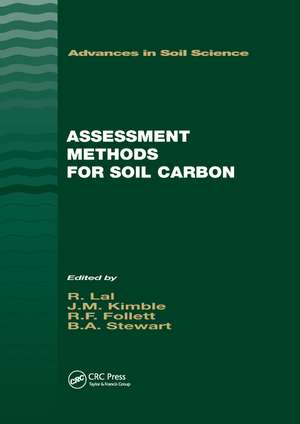Assessment Methods for Soil Carbon
Editat de John M. Kimble, Ronald F. Follett, B. A. Stewarten Limba Engleză Paperback – 10 oct 2019
and preparation, analytical techniques for soil carbon; soil erosion and sedimentation; remote sensing, GIS and modeling; procedures for scaling carbon data from point and local measurements to regional and even national scales; and economic and policy issues.
In Assessment Methods for Soil Carbon, leading researchers show that we now have the ability to measure, monitor, and verify changes to soil carbon. The book establishes the need for standardized methods that can be used by anyone, and helps us better understand the link between the pedosphere (soils) and the atmosphere. It also shows the importance of developing links between the economics of carbon sequestration and the amounts sequestered, and highlights the need for scientists and policy makers to interact to ensure that policies fit within the scope of present technologies.
Preț: 519.19 lei
Preț vechi: 610.82 lei
-15% Nou
Puncte Express: 779
Preț estimativ în valută:
99.35€ • 104.20$ • 82.70£
99.35€ • 104.20$ • 82.70£
Carte tipărită la comandă
Livrare economică 01-15 aprilie
Preluare comenzi: 021 569.72.76
Specificații
ISBN-13: 9780367397685
ISBN-10: 0367397684
Pagini: 696
Dimensiuni: 174 x 246 x 35 mm
Greutate: 1.28 kg
Ediția:1
Editura: CRC Press
Colecția CRC Press
ISBN-10: 0367397684
Pagini: 696
Dimensiuni: 174 x 246 x 35 mm
Greutate: 1.28 kg
Ediția:1
Editura: CRC Press
Colecția CRC Press
Public țintă
Academic and Professional Practice & DevelopmentCuprins
Introduction. Soil Sampling and Sample Preparation. Assessment of Carbon Pools. Assessment of Analytical Techniques. Soil Erosion and Sedimentation. Modeling and Scaling Procedures. Economics and Policy Issues. Synthesis.
Notă biografică
R. Lal, J. M. Kimble, R. F. Follett, B. A. Stewart
Descriere
The Kyoto Protocols heightened interest in soil carbon pools and their effect on carbon fluxes. In Assessment Methods for Soil Carbon, leading researchers show that the technology exists to measure, monitor, and verify changes to soil carbon. The book establishes the need for standardized methods, and sheds light on the link between the pedosphere (soils) and the atmosphere. It shows the importance of developing links between the economics of carbon sequestration and the amounts sequestered and highlights the need for scientists and policy makers to interact to ensure that policies fit within the scope of present technologies.
